Serosu-gil redefines cool for Seoul’s fashion elite
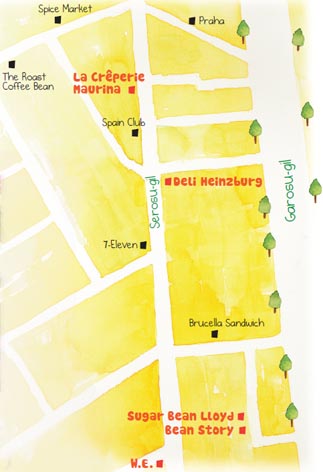
Just a few years ago, Garosu-gil in Sinsa-dong, southern Seoul - an uber-chic street full of trendy boutiques, cafes and restaurants - still retained an edginess that kept it interesting and fresh. But as its quirky vintage shops, rustic cafes and alternative art galleries started giving way to a Starbucks here and a Coffee Bean there, Seoul’s trendsetters began looking for a new hot spot that was fashionably under the radar.
Enter Serosu-gil, a road parallel to Garosu-gil, which has in the last year gained a reputation as the “new” Garosu-gil for trendsetters seeking an exclusive and demure brand of cool.
The name Serosu-gil, which literally translates as “vertical street” in Korean, is a pun on its location and newness (“se” can also mean “new” in Korean). Garosu-gil is named after the trees that line the street, with “garosu” meaning “tree-lined.”
Contrary to popular belief, both streets have been around for a long time. In fact, Serosu-gil began to take shape about 30 years ago, according to Shim Mun-bo, 52, head of real estate agency Dongbang Consulting, which opened in Sinsa-dong around that time.
In the 1980s, local designers including the late Andre Kim, started setting up shop on Garosu-gil. Around the same time, up-scale designer shops including Armani and Benetton started moving to the area.
The area’s future as a fashion district was further solidified when Esmod Seoul, Korea’s biggest fashion school, was established there in 1989.
In the 1990s, the area slowly started to gain a reputation in the fashion industry as an inexpensive place in southern Seoul (compared to the neighboring Apgujeong) to set up their design studios and boutiques. Even so, public recognition of Garosu-gil was limited.
According to shop owners and real estate agents in the area, wine bars, restaurants and cafes started opening up in the early 1990s to fit the palettes of the people involved in the art scene.
Garosu-gil’s golden age started in the mid-1990s, when the younger generation’s interest in luxury brands escalated along with the influx of cultural influences from the West and Japan.
As Garosu-gil started becoming overpopulated, shops started opening a block or so away on Serosu-gil, where the rent is about 50 to 70 percent of that on Garosu-gil, according to Shim.
But for many Serosu-gil shop owners, it’s not the low rent but rather Serosu-gil’s reputation as an artsy, edgier alternative to Garosu-gil that makes it so attractive.
“We picked Serosu-gil as the location for our restaurant because we wanted the exclusivity as well as the lower rent,” said Lee Kyung-hoon, the owner of W.E. dessert cafe. “So far, there have been no drawbacks.”
W.E.’s chic all-white decor makes it seem more like a gallery than a cafe. Its dessert items speak to the new trend in dessert in that they fuse Korean traditional sweets with Western dessert classics.
Meanwhile, other shop owners are as attracted to the street’s location on the fringe as to its avant garde atmosphere.
“Only people who are aware of the Serosu-gil vibe come here,” said Kim Dong-hak, manager of Deli Heinzburg, which has the look and feel of a German pub. The owners spent over a year developing new recipes and all of the food is made on site.
Kim Sung-tae, 35, a Serosu-gil regular, said that he and his girlfriend always go back to Serosu-gil for its understated charm. “We go to Deli Heinzburg often because their food is unique and tasty,” he said.
Others are looking for longevity.
“Like the restaurants in Europe, I want to provide the same high-quality food to my regulars for as long as possible,” said Tony Chung, who owns La Creperie Maurina. With its sky blue exterior and a model of the Eiffel Tower extending to the ceiling, the whole restaurant offers a slice of France in Asia.
Customers like the neighborhood’s peaceful, laid-back atmosphere, which is largely free of the constant construction found in other areas of the city.
“Garosu-gil is too crowded with people,” said Im Hye-jeong, a 29-year-old Web designer. “The stores have fewer people and there are interesting shops to check out. It’s where you can briefly step away from the busy life of the city.”
Baek In-ki, the owner of cafe Bean Story, appreciates the flood of interesting items that the competition in the neighborhood has produced, but he has his own strategy for success.
“Rather than trying to think of something fresh every time, I want to attract customers with a family-like mood,” he said.
Kim Young-joon, the owner of Sugar Bean Lloyd cafe, is more interested in finding a way to make his shop stand out.
“Since competition is fierce among the coffee shops not only on Garosu but also on Serosu, I’ve focused on distinguishing my shop from others,” said Kim.
By Hannah Kim, Lee Jung-hee Contributing writers [estyle@joongang.co.kr]
La Creperie Maurina
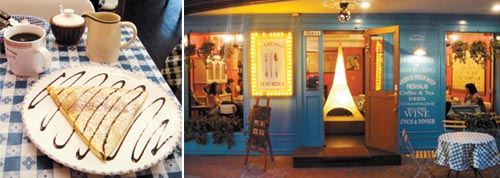
Prices range from 4,000 won ($3.60) to 16,000 won for crepes; drinks range from 4,000 won to 8,000 won.
Hours are 12 p.m. to 10:30 p.m. from Mondays to Saturdays and 12 p.m. to 9 p.m. on Sundays
(02) 541-8283
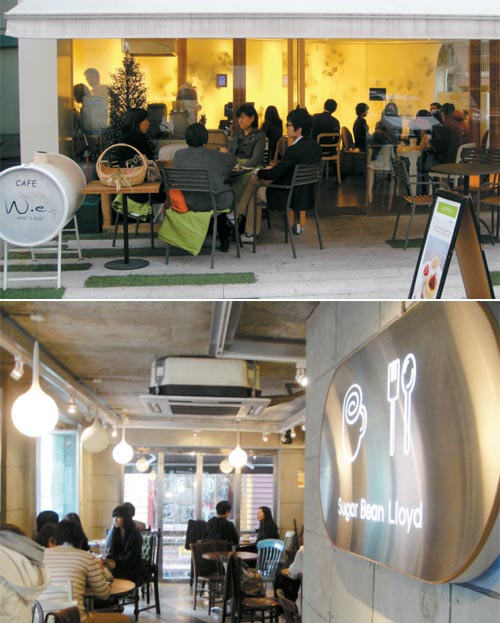
Top: W.E. / Above: Sugar Bean Lloyd
W.E.
The decor of this all-white cafe reflects its menu, which combines the best elements of Western and Asian desserts. The first thing you will notice are the dimly lit Asian flower patterns that decorate the back wall. The cafe’s signature dish is hotteok (honey filled pancakes), which unlike its Korean traditional counterpart is baked, not fried. The dish is topped with Western dessert ingredients such as fruit and ice cream. The cafe is also known for its red bean fondue, which uses red bean paste as its main ingredient.
Prices range from 5,000 won to 16,000 won.
Hours are 11 a.m. to 11 p.m. from Mondays to Saturdays and 2 p.m. to 10 p.m. on Sundays
(02) 3445-0919
Sugar Bean Lloyd
This cafe invites customers in with wide floor to ceiling windows and simple white and gray decor.
Along with coffee that is made by a professional barista, the cafe’s signature item is its “moffles.”
Moffles are a mix of mochi, a rice cake made of sticky rice, and waffles. The dish is then topped with fruit or gelato.
Coffee prices range from 5,000 won to 6,500 won. Moffles range from 10,000 won to 13,000 won.
The cafe is open from 11 a.m. to midnight every day.
(02) 512-7037
Deli Heinzburg
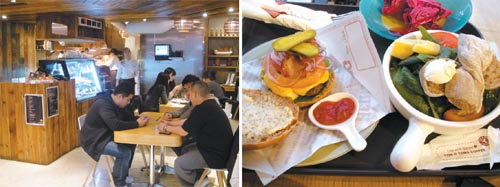
Its unique serving style has waiters bringing the menu while the customers pick up the orders.
The most popular items on the menu are the Onion Ring Burger and Corn Beef and Grilled Cheese Panini. All sauces and ingredients are made right in the shop so that the food is always fresh. The sauces and dressings are also available for sale.
Prices range from 3,000 won to 4,000 won for coffee and 6,000 won to 24,000 won for entrees.
The deli is open from 10 a.m. to 11 p.m. every day.
(02) 541-8780
Bean Story
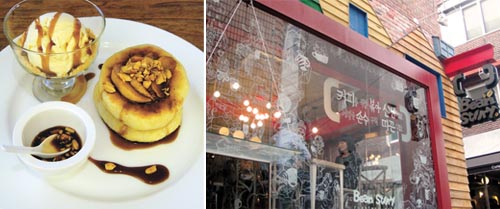
It serves brunch all day to busy designers and fashion industry personnel, meaning you can start your day with breakfast and still sleep in.
The cafe is also famous for its Dutch coffee, which is brewed for over 10 hours in cold water, a process that enhances and deepens the flavor.
Brunch entrees range from 7,800 won to 9,000 won. Coffee prices range from 3,800 won to 7,700 won.
Hours are 9 a.m. to 11:30 p.m. from Mondays to Fridays and 10 a.m. to 11:30 p.m. on weekends.
(02) 3446-3366










with the Korea JoongAng Daily
To write comments, please log in to one of the accounts.
Standards Board Policy (0/250자)